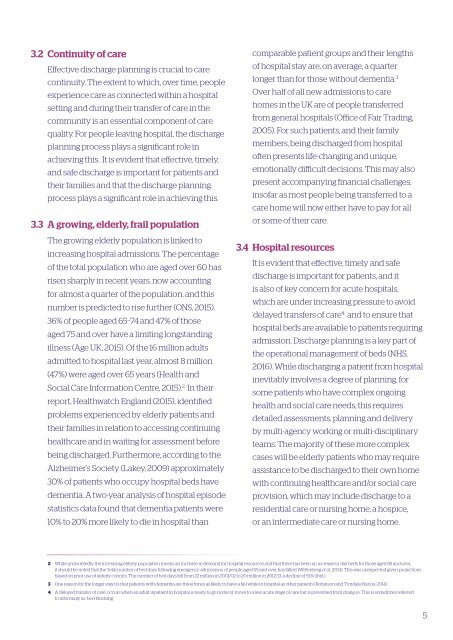Hospital Discharge
WhxH309YqS1
WhxH309YqS1
Create successful ePaper yourself
Turn your PDF publications into a flip-book with our unique Google optimized e-Paper software.
3.2 Continuity of care<br />
Effective discharge planning is crucial to care<br />
continuity. The extent to which, over time, people<br />
experience care as connected within a hospital<br />
setting and during their transfer of care in the<br />
community is an essential component of care<br />
quality. For people leaving hospital, the discharge<br />
planning process plays a significant role in<br />
achieving this. It is evident that effective, timely,<br />
and safe discharge is important for patients and<br />
their families and that the discharge planning<br />
process plays a significant role in achieving this.<br />
3.3 A growing, elderly, frail population<br />
The growing elderly population is linked to<br />
increasing hospital admissions. The percentage<br />
of the total population who are aged over 60 has<br />
risen sharply in recent years, now accounting<br />
for almost a quarter of the population, and this<br />
number is predicted to rise further (ONS, 2015).<br />
36% of people aged 65–74 and 47% of those<br />
aged 75 and over have a limiting longstanding<br />
illness (Age UK, 2015). Of the 16 million adults<br />
admitted to hospital last year, almost 8 million<br />
(47%) were aged over 65 years (Health and<br />
Social Care Information Centre, 2015). 2 In their<br />
report, Healthwatch England (2015), identified<br />
problems experienced by elderly patients and<br />
their families in relation to accessing continuing<br />
healthcare and in waiting for assessment before<br />
being discharged. Furthermore, according to the<br />
Alzheimer’s Society (Lakey, 2009) approximately<br />
30% of patients who occupy hospital beds have<br />
dementia. A two-year analysis of hospital episode<br />
statistics data found that dementia patients were<br />
10% to 20% more likely to die in hospital than<br />
3.4<br />
comparable patient groups and their lengths<br />
of hospital stay are, on average, a quarter<br />
longer than for those without dementia. 3<br />
Over half of all new admissions to care<br />
homes in the UK are of people transferred<br />
from general hospitals (Office of Fair Trading,<br />
2005). For such patients, and their family<br />
members, being discharged from hospital<br />
often presents life-changing and unique,<br />
emotionally difficult decisions. This may also<br />
present accompanying financial challenges,<br />
insofar as most people being transferred to a<br />
care home will now either have to pay for all<br />
or some of their care.<br />
<strong>Hospital</strong> resources<br />
It is evident that effective, timely and safe<br />
discharge is important for patients, and it<br />
is also of key concern for acute hospitals,<br />
which are under increasing pressure to avoid<br />
‘delayed transfers of care’ 4 and to ensure that<br />
hospital beds are available to patients requiring<br />
admission. <strong>Discharge</strong> planning is a key part of<br />
the operational management of beds (NHS,<br />
2016). While discharging a patient from hospital<br />
inevitably involves a degree of planning, for<br />
some patients who have complex ongoing<br />
health and social care needs, this requires<br />
detailed assessments, planning and delivery<br />
by multi-agency working or multi-disciplinary<br />
teams. The majority of these more complex<br />
cases will be elderly patients who may require<br />
assistance to be discharged to their own home<br />
with continuing healthcare and/or social care<br />
provision, which may include discharge to a<br />
residential care or nursing home, a hospice,<br />
or an intermediate care or nursing home.<br />
2 While undoubtedly the increasing elderly population means an increase in demand for hospital resources and that there has been an increase in day beds for those aged 85 and over,<br />
it should be noted that the ‘total number of bed days following emergency admissions of people aged 65 and over has fallen’ (Wittenberg et al., 2014). This was unexpected given projections<br />
based on prior use of elderly cohorts. The number of bed days fell from 22 million in 2001/02 to 20 million in 2012/13, a decline of 9.1% (ibid.).<br />
3 One reason for the longer stays is that patients with dementia are three times as likely to have a fall while in hospital as other patients (Robinson and Tyndale-Biscoe, 2014).<br />
4 A ‘delayed transfer of care’ occurs when an adult inpatient in hospital is ready to go home or move to a less acute stage of care but is prevented from doing so. This is sometimes referred<br />
to informally as ‘bed-blocking’.<br />
5


